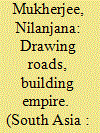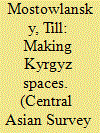|
|
|
Sort Order |
|
|
|
Items / Page
|
|
|
|
|
|
|
| Srl | Item |
| 1 |
ID:
131924


|
|
|
|
|
| Publication |
2014.
|
| Summary/Abstract |
Studies of colonial travel and mobility reveal how spaces are constructed through practices which select and link sites together, drawing fresh itineraries and re-organising places. A series of lithographic sketches published in 1830 as Sketches of the New Road in a Journey from Calcutta to Gyah, drawn by Charles D'Oyly (1781-1845) on his journey from Calcutta to Gaya, captures the tacit colonial imbrication of notions of travel, circulation, landscape and spatial production. An officer posted in various capacities at various places in eastern India in the early part of the nineteenth century, D'Oyly was a prolific amateur painter who sketched and painted different landscapes across the region. His Sketches holds a special significance as his pictures capture and freeze glimpses of a newly-constructed colonial road stretching across the countryside. D'Oyly's plates were intended to celebrate the new colonial circuit as a form of public works, drawing attention away from the urban epicentre of colonial Calcutta. I read this construction as a kind of spatial practice whereby a fresh idea of space emerges through these new operations, supplanting that of pre-colonial India.
|
|
|
|
|
|
|
|
|
|
|
|
|
|
|
|
| 2 |
ID:
115815


|
|
|
|
|
| Publication |
2012.
|
| Summary/Abstract |
In the past decade local scholars in Murghab, Tajikistan's easternmost district, have published several books in Kyrgyz on the history and culture of the Eastern Pamirs. In their work, the authors address the region's predominantly Kyrgyz population by emphasizing the 'kyrgyzness' of the Eastern Pamirs, which they refer to as Sarykol. The results of these local studies reverberate widely on the ground and have become integrated into everyday interaction. As a consequence, not only the region's history and culture, but also its territory, are perceived through an increasingly ethnicized lens. This paper seeks to explore local history as a way of appropriating space. Following Henri Lefebvre (1974), local history can be defined as an ethno-spatial practice that emphasizes ethnicity. Through an analysis of five works on local history and culture and their embedding in an ethnographic context, this article provides evidence for the significance of local studies in 'kyrgyzizing' space. It also demonstrates, moreover, that international non-governmental organizations, through their funding of such research, are entangled with globalized visions of culture, tradition and ethnicity.
|
|
|
|
|
|
|
|
|
|
|
|
|
|
|
|
|
|
|
|
|